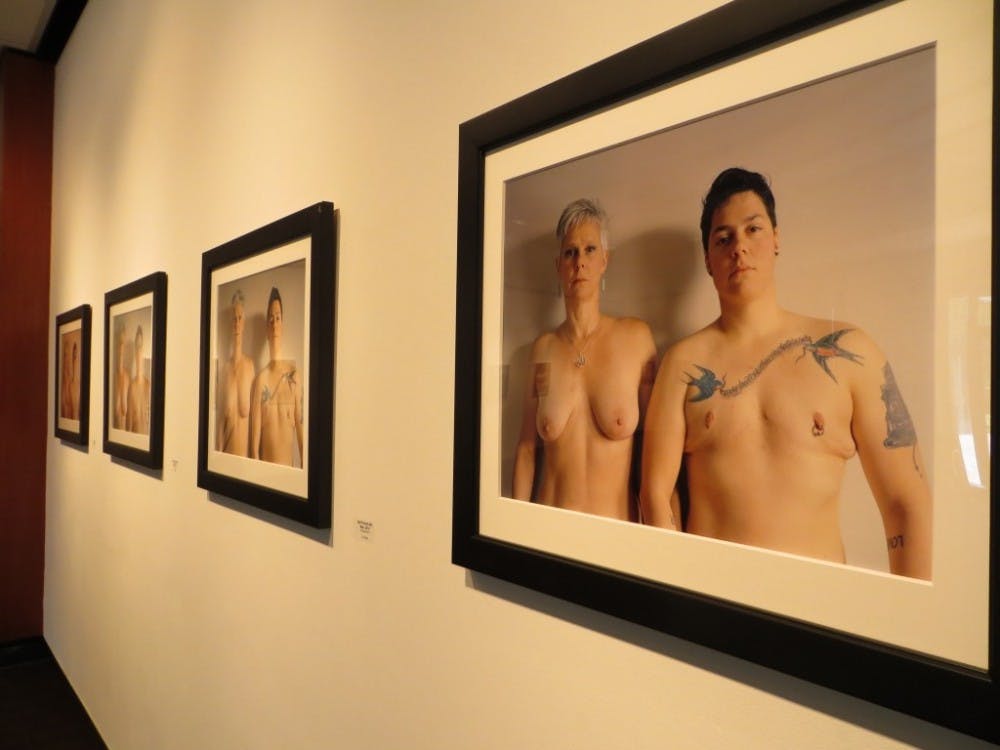Jess Dugan described various details of her identity, such as how she was prom king in high school, before showing her artwork April 15 in the Isabella Cannon Room at Elon University. She said she feels it’s important to show her own identity before beginning a presentation of her photography.
Dugan spoke about her photographs and process for her gallery, “Transcendence 2005- 2012.” The portrait collection visually encompasses the transgender community and illustrates how gender identity and biological sex can contrast.
She doesn’t use studio lighting because she uses a 4-by-5 view camera, in which a cloth goes over the photographer’s head.
Dugan is interested in identity construction, gender construction and how people breed these elements through clothing and expressions.
“The process through which she makes the photographs is different and takes us deeper into these people’s lives,” said Ken Hassell, associate professor of art. “Through that process, we begin to see transgender people as not just kind of ‘weird people’ but as human beings.”
The first time Dugan could pick up a camera after she had chest reconstruction surgery in 2005, she took a self-portrait with her mother, both with bare chests. Dugan said she was trying to make sense of this transformation and new body and wanted to understand herself and the community.
“I was really interested in showing these intimate moments and quiet moments at home,” she said. “At the time there wasn’t that much imagery of trans people I could find.”
Dugan focuses on gender as a performance and costume — a series of behaviors people can choose to embody or not. Her work showcases several relationships, couples and people going through the female-to-male transformation.
Dugan’s photos use direct eye contact to invite the viewer to engage with the subject.
“You’re forced to think how you feel about this person,” she said.
When she receives feedback at her galleries, it’s usually from people not familiar with queer couples, she said.
“They were trying to figure out how their relationship functioned, who was more masculine,” Dugan said. “By the fourth or fifth photograph, they were exhausted.”
Dugan’s goal throughout her gallery showings is to focus on who the people in her photographs are as individuals. She invites the people in her photographs to her galleries because she wants them to be a part of the end process and not just a subject forgotten after the photo shoot.
“For me, as a photographer, the ethics I subscribe to are an important part of my process,” Dugan said. “It’s important to me that the people in my photographs feel like they’re a part of what I’m doing.”
Dugan makes sure to photograph her own body and insert herself into the community to make herself as vulnerable as she’s asking her subjects to be.
“Oftentimes we’re kind of examining other people and there’s this kind of distance that happens and we’re kind of ‘othering’ people,” Hassell said. “She’s willing to be a part of that process and look at herself and examine herself as well as others.”
Dugan said she was interested in this sense of a “chosen family” and how it rejects what is valued in mainstream society.
Hassell said there are many stereotypes and much transgender marginalization in society. He said Dugan’s work humanizes this. “We don’t want to take away their individuality,” Hassell said. “Looking at these photographs — they become personal and you see them as individuals. They’re just different.”


